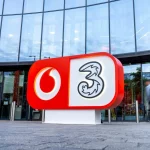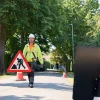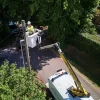EE Miles Ahead of O2, Three UK and Vodafone for 5G Mobile Availability

Network benchmarking provider Ookla, which operates the popular Speedtest.net internet connection testing service, has kindly furnished ISPreview with some additional data that reveals the past and present levels of UK 5G mobile (mobile broadband) availability across EE (BT), Vodafone, Three UK and O2 (Virgin Media). Some of the results may surprise.
Just to be clear. The figures for 5G availability reflect the percentage of users with 5G devices spending most of their time connected to 5G networks. This is not to be confused with the figures for either population coverage or landmass (geographic) coverage of the same network technology.
As previously reported on Monday, the United Kingdom currently achieves a national 5G availability score of 42.2%, which put us behind most of Europe and we’ve already explored some of the reasons for that (here). But Ookla has now kindly also pulled together some new data for ISPreview on the UK’s 5G availability by network operator, which shows how the situation has changed between Q4 2023 and Q4 2024.
Advertisement
Overall, EE leads the pack with a 5G availability score of 67.45% (i.e. they might not tend to beat Three UK for 5G speeds, but availability is over double), which is followed by O2 on 46.11% (O2 often come bottom of many performance studies, but availability seems to be another matter), then Three UK on 31.1% and finally Vodafone places last with a feeble score of 16.37%.

The big differences above will be at least partly related to the strength of existing 4G networks and rising adoption of true end-to-end 5G Standalone networks. But on that front we’re still surprised to see Vodafone trailing so far behind and O2 pulling so far ahead of both Three UK and Vodafone.
Mark is a professional technology writer, IT consultant and computer engineer from Dorset (England), he also founded ISPreview in 1999 and enjoys analysing the latest telecoms and broadband developments. Find me on X (Twitter), Mastodon, Facebook, BlueSky, Threads.net and Linkedin.
« Openreach to Stop Selling 40Mbps FTTC Broadband Tier on 24th April























































I was a happy Vodafone customer for many years, my first 5G handset was the iPhone 12. Never got 5G in the places I lived and worked, never thought much of it as it was new technology. Used to blow me away that Vodafone used to advertise themselves as ‘5G in more places’ but when you digged into it, they were claiming credit for the coverage of Vodafone in Germany, Italy, Ireland and Spain.
I left in 2020 for EE (as they provided my work phone), have absolutely rubbish coverage in my home village but strong 5G everywhere else. I decided to port back to Vodafone in summer 2024 and was shocked not only to see that there’d been zero movement on the 5G coverage but actually, thanks to the 3G switch off, I experienced a lot of not spots or my phone jumping onto 2G. I lasted 3 weeks before giving up and signing a new deal with EE.
They call themselves the nations network, I’m inclined to ask them what nation they’re referring to.
Joking aside, I really hope this merger with 3 is what’s going to kick start real investment in their 5G coverage. I actually liked being a Vodafone customer, just they can’t offer me what I need in their current form.
I would recommend checking the coverage maps before signing up for a new provider.
Business mergers typically cause some turmoil within the new organisation for an average of 18 months, so I would not reply and any significant improvement in the combined group until the end of 2026.
Putting DSS on existing 4G bands don’t make it 5G as it should be known.
Coverage data via mastdatabase shows a still average n78 rollout across the country.
My personal experience is that the 5G availability on EE is driven by DSS on the existing 2100mhz band. Means the 5G icon is visible a lot, but in the absence of a 5G SA service, there’s really very little perceivable difference in end user experience
My experience of EE 5g coverage is very different. The phone rarely drops back to 4g and I get broadband bandwidth for a private network of devices while on the move.
The article fails to highlight that this “study” doesn’t take into account DSS (especially on low bands) vs n78 rollout.
If a carrier switches on 10MHz of DSS n28 users will spend huge amounts of time with a 5G icon, but the experience will be worse than an average 4G coverage.
Isn’t the emphasis now on 5G SA roll-outs?
Vodafone seems very low and O2 seems very high…
Going by what people say about 5G, I am in no rush to get a phone that has it and even when I do, I may disable it.
I am not sure what you are referring to, but 5G on EE is performing well. I also rarely see the device fall back to 4G when I am travelling. Customers of other operators may however experience poorer coverage.
This is without doubt true in my area, I get 5G on EE, speeds around 60 to over 100mbps on my phone, yet on Three I still have 3G turned on and sometimes the phone will fall onto it. It’s speeds also average 10 but can drop to 3 mbps.
In my opinion 5g is still not worth it they still can’t 4g right so what hope is there for 5g
Who are the “they” you are referring to? What are “they” not getting right?
I live in Ealing, London. EE struggles around 1mbit/sec, sometimes even less. Lebara which piggybacks on Vodafone is around 180mbit/sec, sometimes even above 200mbit/sec. Indoors, same spot same device. Similar experience had in Uxbridge.
[ x ] to doubt
EE only has 5G in big cities. Three has 5G everywhere.
Also EEs 5G is mostly fake
Wrong on both counts. EE has most of the UK covered though there are still largish areas where service is not available. EE has far more extensive coverage of the UK than Three. Take a look at the numbers and the coverage maps.
O2 are the worst provider i ever went with, constant dropped calls, never any internet, I was told when I complained that they were upgrading masts in my area so the performance would be poor for a while, six months later I’d had enough and had to take them to the ombudsman to get a full refund and cancellation without penalty
I’m with EE now and it’s superb, we had a storm recently that knocked out our internet but I just set my iPhone as a hotspot and the EE SIM served the entire house for nine days flawlessly, streaming, browsing not an issue, was very impressed I must say
I had virtually the same experience though I did not bother with the ombudsman. Switch from O2 to EE and now I have no connectivity issues. I also used the iPhone as a HotSpot for my office while my broadband was knocked out by a failed upgrade (due in the end to other providers not updating records fo changes made in the local cabinet).
I’d say I’m surprised that O2 has the second highest 5G coverage, but I’m not. Sure, it’s just a bunch of n28 but it still makes a reasonable difference to me with up to 150/50mbps in my experience on B1+n28.
They’ve started putting n28 in quite a few Vodafone host areas and it seems like they’re linearly increasing 5G coverage from those maps.
Never seen any EE where I live on 2g, 3g, 4g or 5g in the last 15 years. I am mnot holding my breath!
I have checked O2 in SW and W London. It really is pretty poor in both parts of London.
They really need to invest in more critical infrastructure.
Why don’t they do they do more studies on indoor coverage, where people actually use their phones?
I can guarantee EE and Three will score laughably badly on those metrics.
Gigabit The coverage is hit & miss from every network. Sometimes it is just pot luck for a good or bad signal!
My old flat a black spot almost zero signal for Three. So changed to O2 with slow speeds but at least a signal.
Fast forward my new flat only 400 metres from the last flat. Back with Three and now regularly get a super fast 460Mbps 5G inside my flat!
5G in the UK has been a huge deception. Customers are seeing 4G LTE speeds if lucky with a fraction of the coverage.
As for Three – yearly price rises combined with yearly performance drops. In 2019 I paid £18 for 80mbps Home 4G, now it’s £23 for 30-40mbps.
I used to have 80mbps with 4GLTE in my area, once the 5G introduction, and the ‘upgrades’ resulted in network performance collapse, but that’s not the worst of it. Multiple outages, Xbox blocked for over a month, Netflix blocked for a few months – all which Three denied until high numbers of complaints online forced them to accept fault and fix blaming an accidental configuration error, then after another upgrade they screwed up their network again forcing home 4G users to switch to their mobile three.co.uk to gain access to banking, and access basic router features – which Three still deny is happening to this day.
It’s 2025, and mobile network operators are still unable to provide reliable service despite constant price hikes.